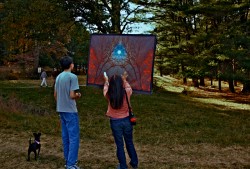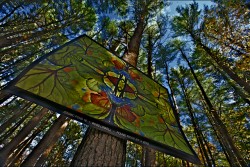 Ross Lowell has a storied history in the movie business as an award-winning cinematographer and director. In recent years, Lowell says, “I’ve found myself bringing the filmmaker’s fascination with motion and time into the realm of still photography.”
Ross Lowell has a storied history in the movie business as an award-winning cinematographer and director. In recent years, Lowell says, “I’ve found myself bringing the filmmaker’s fascination with motion and time into the realm of still photography.”
Lowell’s most recent exhibition, entitled Time Trails in Trees, is a culmination of Lowell’s often abstract photography of natural formations using single images with no layering, usually in mirrored combinations. The images were photographed on-location in New York, Utah, California and Oregon, edited in Aperture and further adjusted by photographer friend Josh Dick in Photoshop to prepare the images for large, high-quality printing.
Time Trails in Trees was displayed on more than 20 banners, hung at eye level in and amongst the trees of the Ward Pound Ridge Reservation in Westchester County, N.Y.
 Because the exhibition would be outdoors for a month the banners had to be extra-durable. Moreover, the rich details, contrast and color of Lowell’s photography demanded the best possible reproduction. Given these parameters, the National Geographic Society’s graphics shop, National Geographic Imaging, produced the exhibition with an Epson GS6000 on LexJet banner material.
Because the exhibition would be outdoors for a month the banners had to be extra-durable. Moreover, the rich details, contrast and color of Lowell’s photography demanded the best possible reproduction. Given these parameters, the National Geographic Society’s graphics shop, National Geographic Imaging, produced the exhibition with an Epson GS6000 on LexJet banner material.
“I couldn’t have asked for more; it was a fabulous job,” says Lowell. “More than the photography, the setting and the size of the images were responsible for the impact it had on the people who came out to see it.”
The 54-in. x 78-in. banners were attached to the trees with lines suspended to poles on the tops of the banners. In this case, the poles National Geographic Imaging used were galvanized steel 3/4-in. electrical conduit.
 “Since the images were full bleed we weren’t able to do a typical 2 1/2-in. pole pocket. Instead of PVC we went with conduit, which is very sturdy for the diameter and can support a lot of weight for its thickness. It’s inexpensive, yet strong. Plus, the conduit is actually easier to recycle than PVC,” explains National Geographic Imaging’s production manager Patrick Sweigert. The graphics shop used LexJet Heavy Duty Banner Tape to hem the pole pockets.
“Since the images were full bleed we weren’t able to do a typical 2 1/2-in. pole pocket. Instead of PVC we went with conduit, which is very sturdy for the diameter and can support a lot of weight for its thickness. It’s inexpensive, yet strong. Plus, the conduit is actually easier to recycle than PVC,” explains National Geographic Imaging’s production manager Patrick Sweigert. The graphics shop used LexJet Heavy Duty Banner Tape to hem the pole pockets.
Based on the success of the Pound Ridge exhibition, made possible by curator Rick Rogers, Lowell plans on similar exhibitions across the country.

